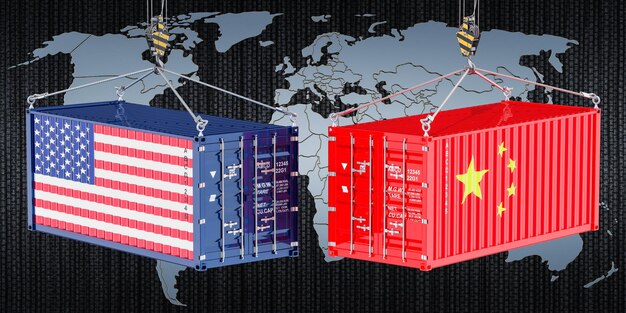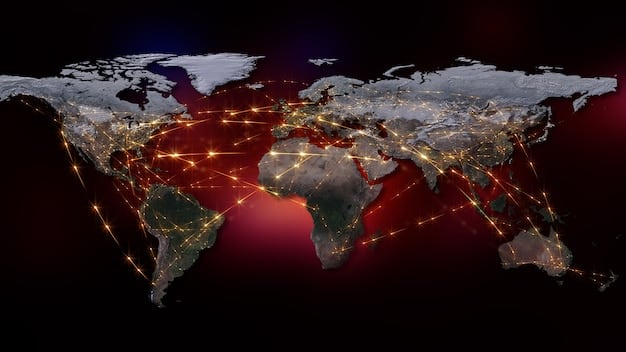US Trade Policies: Impact on Your Business & Global Trade

US trade policies significantly influence global commerce, impacting various sectors from manufacturing to technological innovation, requiring businesses to adapt strategies to navigate tariffs, regulations, and international agreements.
Navigating the complex landscape of US trade policies: understanding the impact on your business is crucial for any enterprise, regardless of its size or sector. These policies, often shifting and multifaceted, can profoundly affect everything from supply chains and production costs to market access and competitive advantage.
the evolution of US trade policy: a historical overview
The United States, as a global economic powerhouse, has a trade policy history marked by periods of protectionism, liberalization, and strategic engagement. Understanding this evolution provides critical context for contemporary challenges and opportunities. From the early days of tariffs designed to protect nascent domestic industries to post-World War II efforts to establish a rules-based global trading system, each era has left an indelible mark.
From protectionism to multilateralism
In its formative years, US trade policy largely emphasized protectionism, safeguarding emerging industries from foreign competition. The high tariffs imposed throughout the 19th and early 20th centuries, such as the Smoot-Hawley Tariff Act of 1930, aimed to bolster domestic production but often led to retaliatory measures from other nations, exacerbating economic downturns. This isolationist approach eventually gave way to a recognition of the benefits of international cooperation.
- Early tariffs protected infant industries.
- Smoot-Hawley Tariff worsened the Great Depression.
- Post-WWII shift towards global trade liberalization.
The post-World War II era ushered in a new philosophy, deeply rooted in the belief that open trade fosters peace and prosperity. The General Agreement on Tariffs and Trade (GATT), established in 1947, laid the groundwork for a more multilateral system, aiming to reduce trade barriers and promote fair competition. The US was a primary architect of this new order, championing institutions like the International Monetary Fund (IMF) and the World Bank.
The rise of regional trade agreements and bilateralism
While multilateralism through the World Trade Organization (WTO) remained a cornerstone, the late 20th and early 21st centuries saw a proliferation of regional and bilateral trade agreements. Agreements like the North American Free Trade Agreement (NAFTA), later replaced by the US-Mexico-Canada Agreement (USMCA), exemplified a trend towards preferential access within specific geographic blocs. These agreements often went beyond simple tariff reductions, addressing issues such as intellectual property rights, labor standards, and environmental protections.
The strategic rationale behind these agreements was multifaceted. Economically, they aimed to create larger, more integrated markets, facilitating economies of scale and attracting foreign direct investment. Politically, they could be used to solidify alliances and project influence. However, this shift also introduced complexities, creating a patchwork of rules and potentially diverting trade from more efficient global suppliers. The careful balance between multilateral and regional approaches continues to define US trade policy debates.
The evolution of US trade policy is an ongoing saga, reflecting changing economic realities, geopolitical considerations, and domestic priorities. Businesses operating today must understand this historical context to anticipate future policy directions and position themselves strategically in the global marketplace. This intricate dance between national interest and global integration constantly reshapes the opportunities and challenges faced by companies worldwide.
key instruments of US trade policy: how they function
Understanding the specific tools and mechanisms the US government employs to implement its trade policies is essential for businesses seeking to navigate the international trade environment effectively. These instruments range from tariffs and quotas to sophisticated legal frameworks and enforcement actions, each designed to achieve particular economic or political objectives.
Tariffs and non-tariff barriers
Tariffs, essentially taxes on imported goods, are perhaps the most direct and historically significant tool of trade policy. They increase the cost of foreign goods, making domestic products more competitive. While historically used to protect nascent industries, contemporary tariffs are often employed to address trade imbalances, retaliate against unfair trade practices, or exert diplomatic pressure. The application of tariffs can significantly impact supply chain costs, pricing strategies, and consumer demand.
Non-tariff barriers (NTBs), on the other hand, encompass a broader array of measures that restrict trade without imposing direct taxes. These include quotas, which limit the quantity of specific goods that can be imported; import licensing requirements; stringent product standards; and complex customs procedures. While some NTBs serve legitimate purposes, such as protecting consumer safety or the environment, they can also be used as disguised protectionist measures, creating bureaucratic hurdles and increasing compliance costs for businesses.
Trade agreements and dispute resolution
Bilateral, regional, and multilateral trade agreements form the intricate web that governs much of global commerce. These agreements are designed to reduce trade barriers, harmonize regulations, and establish clear rules for international trade. For businesses, these agreements can unlock new markets, provide greater certainty for cross-border transactions, and foster a more predictable trading environment. Prominent examples include the WTO agreements, USMCA, and various free trade agreements (FTAs) with individual countries.
However, even with robust agreements, disputes inevitably arise. The US utilizes various mechanisms for dispute resolution, often through the WTO dispute settlement system or provisions within its bilateral and regional agreements. These processes allow countries to challenge perceived breaches of trade rules and seek remedies. For businesses involved in international trade, understanding these dispute resolution mechanisms is crucial, as they can impact market access, intellectual property rights, and investment protections. The outcomes of these disputes can set precedents, shaping future trade practices and policies.
The deliberate deployment of these trade policy instruments requires businesses to monitor policy shifts, adapt their operations, and engage with policymakers when appropriate. The choice of instrument reflects the US government’s strategic priorities at any given moment, making a dynamic understanding of these tools vital for informed business decision-making.

direct impacts on US businesses: supply chains, costs, and competitiveness
The direct impacts of US trade policies on domestic businesses are manifold, profoundly influencing operational efficiency, financial viability, and market positioning. Companies must critically assess how policymaking ripples through their supply chains, affects their cost structures, and alters their competitive landscape.
Supply chain disruptions and diversification
One of the most immediate and significant impacts of US trade policies, particularly tariffs or import restrictions, is on global supply chains. Businesses that rely heavily on imported components or finished goods from targeted countries may face sudden, substantial increases in costs. This can force companies to rethink their sourcing strategies, potentially leading to diversification away from traditional suppliers. While diversification can enhance resilience by reducing reliance on a single region or country, it often comes with its own set of challenges, including:
- Increased R&D costs for new materials or designs.
- Higher logistics expenses due to longer or more complex routes.
- The need to establish new supplier relationships, which can be time-consuming.
Moreover, trade tensions can create uncertainty, making long-term planning difficult. Businesses may hold larger inventories to mitigate potential disruptions, tying up capital and increasing storage costs. The imperative to build more resilient and agile supply chains has become a central focus for many US businesses in response to evolving trade dynamics.
Changes in import/export costs and pricing strategies
Tariffs directly increase the cost of imports for US businesses. These increased costs can either be absorbed by the company, reducing profit margins, or passed on to consumers in the form of higher prices. The decision of whether to absorb or pass on costs depends on market demand elasticity, competitive pressures, and the company’s overall financial health. If costs are passed on, it can lead to reduced sales volume, particularly for price-sensitive goods.
Conversely, quotas or export subsidies can impact businesses differently. Export subsidies, while less common, can make US goods more competitive internationally. However, retaliatory tariffs from other countries due to US actions can harm US exporters, making their products more expensive in foreign markets and eroding their global market share. Businesses must constantly monitor these cost shifts and adjust their pricing strategies to remain competitive while maintaining profitability. The fluctuating nature of these costs demands dynamic financial modeling and robust risk management.
Ultimately, the direct impacts of US trade policies on supply chains, costs, and competitiveness necessitate a proactive approach from businesses. Adapting sourcing strategies, optimizing logistics, and refining pricing models are not merely reactive measures but essential components of long-term business resilience in a world shaped by dynamic trade policies.
indirect consequences: innovation, investment, and job markets
Beyond the immediate effects on direct trade, US trade policies also cast long shadows over broader economic ecosystems, influencing patterns of innovation, foreign direct investment (FDI), and the dynamics of the domestic job market. These indirect consequences can be as significant, if not more so, than the direct impacts.
Impact on foreign direct investment (FDI)
Trade policies can significantly influence the attractiveness of the US as a destination for foreign direct investment. Stable, predictable trade relations and open markets tend to encourage FDI, as foreign companies are more likely to invest in facilities, technology, and hiring when they have clear access to US consumers and supply chains. Conversely, protectionist measures, such as high tariffs or strict national security reviews of foreign takeovers, can deter FDI. Investors may perceive increased risk or reduced market access, leading them to seek more favorable environments elsewhere.
- Stable trade policies attract FDI.
- Protectionism can deter foreign investment.
- FDI impacts job creation and technology transfer.
A decline in FDI can have detrimental effects, potentially reducing capital inflows into the US economy, hindering job creation, and slowing the transfer of new technologies and management practices. Moreover, the reciprocal nature of investment means that US companies seeking to invest abroad may also face barriers if other countries retaliate against US trade policies. The flow of capital and investment is highly sensitive to policy signals, making it a critical barometer of the broader economic impact of trade decisions.
Effects on domestic innovation and technology transfer
Trade policies play a crucial role in shaping the landscape of domestic innovation and technology transfer. Open trade policies, particularly those that protect intellectual property rights, can encourage cross-border collaboration, facilitate the exchange of ideas, and provide access to global research and development networks. This can spur innovation within the US by allowing companies to leverage international advancements and market insights.
Conversely, policies that restrict the flow of goods or technology, often cited for national security concerns, can inadvertently stifle innovation. If US companies cannot access certain cutting-edge components or collaborate with leading international researchers, their own pace of innovation might slow. Similarly, the imposition of tariffs or other trade barriers can increase the cost of imported high-tech components, making it more expensive for US firms to develop new products or implement advanced manufacturing processes. The delicate balance lies in protecting strategic national interests without isolating domestic industries from the global currents of innovation.
Influence on the US job market
The impact of trade policies on the US job market is complex and often debated. While some claim protectionist measures “save” domestic jobs by shielding industries from foreign competition, others argue that over time, these policies can lead to higher consumer prices and reduced overall economic efficiency, potentially harming employment in other sectors. Liberalized trade, on the other hand, can lead to job losses in import-competing industries but create new jobs in export-oriented sectors and those benefiting from lower-cost inputs.
The shift of manufacturing overseas, often attributed to lower labor costs, is a pervasive concern. However, trade policies also influence the adoption of automation and advanced manufacturing technologies. When import costs rise, it can incentivize domestic production, but not necessarily human labor; it might instead accelerate investment in automation to achieve cost efficiencies. Thus, the real impact on jobs is less about simple numbers and more about the quality and type of jobs created or displaced, and the necessity for workforce retraining programs to adapt to an evolving economic landscape.
sector-specific insights: industries most affected by trade policy
The impact of US trade policies is rarely uniform across the entire economy; rather, it often disproportionately affects specific sectors. Understanding these sector-specific dynamics is crucial for businesses, investors, and policymakers alike, as it highlights areas of vulnerability and opportunity.
Manufacturing and automotive sectors
The manufacturing sector, particularly the automotive industry, is highly susceptible to shifts in US trade policy. Tariffs on steel and aluminum, for instance, directly increase input costs for car manufacturers, who rely heavily on these materials. This can lead to higher production costs, potentially translating to increased vehicle prices for consumers or reduced profit margins for automakers. Furthermore, rules of origin under trade agreements like the USMCA dictate the percentage of components that must be sourced within a specific region to qualify for tariff-free trade.
- Tariffs on raw materials impact production costs.
- Rules of origin influence supply chain dependency.
- Trade policy affects global competitiveness and sales.
Changes in these rules can force automotive companies to redesign their supply chains and potentially re-onshore production, a costly and complex undertaking. For example, some manufacturers might find it financially advantageous to invest in expanding their US-based operations to meet local content requirements, while others might struggle to adapt, facing higher tariffs on exported vehicles or components. The global interconnectedness of the automotive supply chain means that policies affecting one part of the world can have significant ripple effects on production and sales across continents.
Agriculture and food industries
The American agriculture and food sectors are particularly sensitive to trade policy changes due to their strong reliance on export markets and global commodity prices. Retaliatory tariffs imposed by other nations on US agricultural products, such as soybeans, pork, or dairy, can severely impact farmers’ livelihoods by reducing their access to key export destinations. This can lead to oversupply in the domestic market, driving down prices for producers and potentially necessitating government subsidies or aid.
Moreover, non-tariff barriers related to sanitary and phytosanitary (SPS) standards—rules concerning food safety and plant or animal health—can also act as significant trade impediments. While these standards are often legitimate, they can be manipulated for protectionist purposes. Changes in trade policy can also influence the import of certain food items, affecting consumer prices and the competitiveness of domestic food processors. Maintaining open and fair trade relationships is paramount for the continued prosperity of the US agricultural sector.
Technology and services sectors
While often perceived as less directly impacted by tariffs on goods, the technology and services sectors are profoundly affected by trade policies related to intellectual property, data flows, and labor mobility. Trade agreements increasingly include provisions on digital trade, covering issues such as cross-border data transfer, source code protection, and market access for digital services. Restrictive policies, such as data localization requirements, can significantly impede the operations of global tech companies and limit their ability to deliver services efficiently across borders.
For the services sector, including financial services, professional services, and tourism, trade policies influence market access for foreign providers and the ability of US companies to export their expertise. Visa policies, for instance, directly affect the movement of skilled professionals, which is critical for many service industries. Furthermore, the burgeoning area of artificial intelligence and emerging technologies is increasingly becoming a focus of trade policy discussions, with nations vying for technological leadership and attempting to control strategic technologies through export controls or investment reviews. The nuanced interplay of technology, services, and trade policies means that these industries must pay close attention to evolving regulations and international agreements.
future outlook: emerging trends and challenges in US trade policy
The landscape of US trade policy is dynamic, constantly evolving in response to geopolitical shifts, technological advancements, and domestic priorities. Predicting the future requires an understanding of the emerging trends and the complex challenges that will likely shape policy decisions in the coming years.
Geopolitical shifts and national security concerns
One of the most significant trends impacting US trade policy is the increasing integration of geopolitical considerations, particularly national security, into trade decisions. The rise of strategic competition, especially with China, has led to a greater emphasis on decoupling supply chains in critical sectors, controlling access to advanced technologies, and scrutinizing foreign investments on national security grounds. This trend is likely to continue, potentially leading to:
- More stringent export controls on dual-use technologies.
- Increased domestic production of strategic goods like semiconductors.
- Greater pressure on allies to align their trade policies.
This shift suggests that economic efficiency may, at times, be secondary to national security objectives, leading to more targeted and potentially restrictive trade measures. Businesses operating in sensitive sectors will face increased regulatory scrutiny and may need to localize parts of their operations or diversify their supply chains away from perceived high-risk regions.
Climate change and environmental sustainability
Climate change and environmental sustainability are rapidly becoming central tenets of trade policy discussions. There is growing pressure for trade agreements to include stronger environmental provisions, and for countries to consider carbon border adjustments or other mechanisms to level the playing field for industries facing stricter domestic environmental regulations. The US may increasingly use its trade policy to push for global environmental standards or to penalize countries perceived as not meeting their climate commitments.
This trend presents both challenges and opportunities for businesses. Industries with high carbon footprints may face increased costs and new compliance requirements related to international trade. Conversely, companies specializing in green technologies, renewable energy, or sustainable supply chain solutions may find new markets and policy support. The integration of environmental goals into trade policy signifies a shift towards a more value-driven approach to international commerce.
Digital trade and data governance
The rapid expansion of the digital economy has brought digital trade and data governance to the forefront of trade policy. Issues such as cross-border data flows, data localization requirements, digital taxation, and cybersecurity are increasingly complex and contentious. As more economic activity moves online, countries are grappling with how to regulate these new forms of trade without stifling innovation or compromising national interests.
The US is likely to continue advocating for open digital trade flows, but domestic concerns about privacy and national security will also shape its approach. Businesses that rely on international data transfers or provide digital services will need to navigate a growing patchwork of national data regulations. The development of international norms and agreements around digital trade will be crucial for providing clarity and stability for the global digital economy. The interplay between innovation, data privacy, and trade will define a significant portion of future trade policy debates.
| Key Area | Brief Impact Summary |
|---|---|
| ⛓️ Supply Chains | Policies can disrupt or necessitate diversification through tariffs/restrictions. |
| 💰 Costs & Pricing | Tariffs increase import costs, impacting profit margins or consumer prices. |
| 💡 Innovation | Open policies foster tech exchange; restrictive policies can slow progress. |
| 💼 Job Market | Complex effects: job shifts between import-competing and export sectors. |
frequently asked questions about US trade policies
The primary goals of US trade policy generally include promoting economic growth, fostering fair competition, opening foreign markets for US goods and services, securing national security interests, and protecting human rights and labor standards globally. These objectives often involve a balance between domestic industry protection and international economic engagement.
Tariffs can significantly impact American consumers by increasing the price of imported goods. Businesses might pass these additional costs onto consumers, making products more expensive. Tariffs can also reduce consumer choice if certain imported goods become prohibitively expensive or unavailable due to high duties or restrictions, limiting market variety.
The World Trade Organization (WTO) serves as the primary international body for regulating global trade. For the US, the WTO provides a framework for multilateral trade agreements, a forum for trade negotiations, and a dispute settlement mechanism for resolving trade conflicts with other member countries. It aims to ensure fair and predictable trade rules for all participants.
Businesses can prepare for trade policy shifts by diversifying supply chains, closely monitoring policy developments, engaging with trade associations, and conducting scenario planning. Assessing reliance on specific inputs or markets, building flexibility into operations, and exploring strategies like onshoring or nearshoring can also mitigate potential disruptions and ensure resilience.
Yes, US trade policies can disproportionately affect small businesses. They often have fewer resources to absorb increased costs from tariffs, navigate complex regulations, or diversify supply chains quickly. Small businesses relying on international trade may find it harder to compete if policy changes increase their operational burdens or reduce market access, requiring specialized support.
conclusion
The intricate web of US trade policies represents a continuous challenge and opportunity for businesses operating in the global economy. From tariffs and trade agreements to emerging concerns over supply chain resilience and national security, these policies profoundly shape strategic decisions across all sectors. Adapting to this dynamic environment requires vigilance, foresight, and a deep understanding of both direct and indirect impacts. Ultimately, navigating the evolving currents of US trade policy is not merely about compliance, but about proactively positioning your business for sustained growth and competitiveness.





